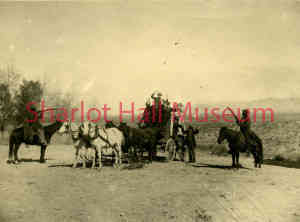By Bob Baker
On October 5, 1869, James O. Grant, owner of the Arizona Stage Line, arrived in Prescott on his stagecoach pulled by six mules. His arrival heralded the first scheduled public passenger service from Prescott to San Bernardino, California. The stage route ran through Yavapai County and included stops at American Ranch, Skull Valley, Date Creek, Wickenburg and La Paz. Later, stage service to Phoenix was added.
 Stage drivers and passengers alike had to deal with harsh weather conditions, extreme temperatures and mountainous terrain. They also had to deal with other mishaps. The Weekly Journal-Miner reported on May 4,1892, that the Black Canyon Stage, “While coming down a steep hill the vehicle upset, throwing the passengers all in a heap. The stage was pretty badly broken up but none of the passengers were seriously injured.” In his book Last Stage Ride & More, Michael Sanford tells the story of a drunken stagecoach driver traveling in heavy snow down a steep hill into Prescott. William “Buckey O’Neill” and Price Behan, Deputy Marshall, (both passengers) quickly realized the driver was out of control. After climbing onto the roof, O’Neill pulled the driver from his seat while Barnes took the reins, stopping the coach. O’Neill handcuffed the driver, and they put him in the boot until they reached the next station.
Stage drivers and passengers alike had to deal with harsh weather conditions, extreme temperatures and mountainous terrain. They also had to deal with other mishaps. The Weekly Journal-Miner reported on May 4,1892, that the Black Canyon Stage, “While coming down a steep hill the vehicle upset, throwing the passengers all in a heap. The stage was pretty badly broken up but none of the passengers were seriously injured.” In his book Last Stage Ride & More, Michael Sanford tells the story of a drunken stagecoach driver traveling in heavy snow down a steep hill into Prescott. William “Buckey O’Neill” and Price Behan, Deputy Marshall, (both passengers) quickly realized the driver was out of control. After climbing onto the roof, O’Neill pulled the driver from his seat while Barnes took the reins, stopping the coach. O’Neill handcuffed the driver, and they put him in the boot until they reached the next station.
A similar but fatal incident occurred on February 12, 1875, at the Prescott Station of the Arizona and California Stage Line. John Evans, the station manager, ordered Jim Carroll, one of his drivers, to get off the stage, as he was too drunk to drive. Carroll refused and began shooting at Evans. Evans returned fire, killing Carroll.
Highway robberies were a grave concern. 132 stage robberies were reported from 1875-1903 in the Arizona Territory. Yavapai County accounted for 34 of these robberies. Thankfully, most stage robberies didn’t result in injury or death. Nevertheless, they posed a serious threat to life and resulted in significant economic losses.
 On January 12, 1877, The Weekly Arizona Miner reported this account by Jesus Lujan, the driver, and J.H. Evans, the mail guard, of a stage robbery on January 4, 1877. While the stage was going around Woolsey Hill, two masked men yelled “halt” just as the lead animals ran into a rope across the road, bringing them to a “dead halt.” One of the robbers asked, “How many passengers?” and Lujan answered “two.” One of the robbers ordered Lujan and Evans off the stage, while the passengers remained on board. The other robber searched them for weapons and found none. Then he took both the mail bag and express box off the stage. After successfully breaking open the express box, they ordered the driver to drive off.
On January 12, 1877, The Weekly Arizona Miner reported this account by Jesus Lujan, the driver, and J.H. Evans, the mail guard, of a stage robbery on January 4, 1877. While the stage was going around Woolsey Hill, two masked men yelled “halt” just as the lead animals ran into a rope across the road, bringing them to a “dead halt.” One of the robbers asked, “How many passengers?” and Lujan answered “two.” One of the robbers ordered Lujan and Evans off the stage, while the passengers remained on board. The other robber searched them for weapons and found none. Then he took both the mail bag and express box off the stage. After successfully breaking open the express box, they ordered the driver to drive off.
On May 4, 1877, the westbound stage from Wickenburg was held up and both passengers were robbed, one being the local sheriff. On September 27, 1877, the California-bound stagecoach from Prescott was stopped by “a lone highwayman” eight miles past Antelope Station. He took the express box and mail but didn’t molest the passengers.

Unfortunately, there were exceptions when passengers or employees were killed or injured. On November 26, 1879, three robbers held up the Prescott to Phoenix stage. When the stage stopped, one of them pulled Mr. Thomas, the only passenger, from the coach and stabbed him multiple times. When he didn’t succumb to those wounds, the robber shot him in the head. One of the robbers was later convicted and hanged for this crime, the first hanging in Phoenix.
Riding the stage through Yavapai County was truly a wild west adventure!
To learn more, come listen to Bob Baker’s lecture 7/15/2023 at 2 pm at the Sharlot Hall Museum in the Education Center Auditorium. Tickets are $15 or FREE for museum members. Seating is limited.
“Days Past” is a collaborative project of the Sharlot Hall Museum and the Prescott Corral of Westerners International (www.prescottcorral.org).This and other Days Past articles are also available at www.archives.sharlothallmuseum.org/articles/days-past-articles/1 The public is encouraged to submit proposed articles and inquiries to dayspast@sharlothallmuseum.org
Please contact SHM Research Center reference desk at 928-277-2003, or via email at archivesrequest@sharlothallmuseum.org for information or assistance with photo requests.


